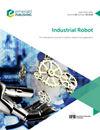The implementation and performance evaluation for a smart robot with edge computing algorithms
IF 2.5
4区 计算机科学
Q3 ENGINEERING, INDUSTRIAL
Industrial Robot-The International Journal of Robotics Research and Application
Pub Date : 2022-07-15
DOI:10.1108/ir-02-2022-0045
引用次数: 1
Abstract
Purpose Apart from, the smart edge computing (EC) robot (SECR) provides the tools to manage Internet of things (IoT) services in the edge landscape by means of real-world test-bed designed in ECR. Eventually, based on the results from two experiments held in little constrained condition, such as the maximum data size is 2GB, the performance of the proposed techniques demonstrate the effectiveness, scalability and performance efficiency of the proposed IoT model. Design/methodology/approach Certainly, the proposed SECR is trying primarily to take over other traditional static robots in a centralized or distributed cloud environment. One aspect of representation of the proposed edge computing algorithms is due to challenge to slow down the consumption of time which happened in an artificial intelligence (AI) robot system. Thus, the developed SECR trained by tiny machine learning (TinyML) techniques to develop a decentralized and dynamic software environment. Findings Specifically, the waste time of SECR has actually slowed down when it is embedded with Edge Computing devices in the demonstration of data transmission within different paths. The TinyML is applied to train with image data sets for generating a framework running in the SECR for the recognition which has also proved with a second complete experiment. Originality/value The work presented in this paper is the first research effort, and which is focusing on resource allocation and dynamic path selection for edge computing. The developed platform using a decoupled resource management model that manages the allocation of micro node resources independent of the service provisioning performed at the cloud and manager nodes. Besides, the algorithm of the edge computing management is established with different path and pass large data to cloud and receive it. In this work which considered the SECR framework is able to perform the same function as that supports to the multi-dimensional scaling (MDS).基于边缘计算算法的智能机器人的实现与性能评估
除此之外,智能边缘计算(EC)机器人(SECR)通过在ECR中设计的真实测试平台,提供了在边缘环境中管理物联网(IoT)服务的工具。最后,基于在最小约束条件下(如最大数据大小为2GB)进行的两个实验的结果,所提出的技术的性能证明了所提出的物联网模型的有效性、可扩展性和性能效率。设计/方法论/方法当然,拟议的SECR主要试图在集中式或分布式云环境中接管其他传统的静态机器人。所提出的边缘计算算法表示的一个方面是由于减缓人工智能(AI)机器人系统中发生的时间消耗的挑战。因此,开发的SECR通过微型机器学习(TinyML)技术进行训练,以开发分散和动态的软件环境。具体而言,在不同路径的数据传输演示中,嵌入边缘计算设备后,SECR的浪费时间实际上有所减缓。应用TinyML对图像数据集进行训练,生成在SECR中运行的识别框架,并通过第二次完整实验证明了该框架的有效性。本文是针对边缘计算资源分配和动态路径选择的初步研究工作。开发的平台使用解耦的资源管理模型,该模型管理独立于云和管理节点上执行的服务供应的微节点资源分配。此外,采用不同路径建立边缘计算管理算法,将大数据传递到云端接收。在本研究中,考虑了SECR框架能够执行与支持多维缩放(MDS)相同的功能。
本文章由计算机程序翻译,如有差异,请以英文原文为准。
求助全文
约1分钟内获得全文
求助全文
来源期刊
CiteScore
4.50
自引率
16.70%
发文量
86
审稿时长
5.7 months
期刊介绍:
Industrial Robot publishes peer reviewed research articles, technology reviews and specially commissioned case studies. Each issue includes high quality content covering all aspects of robotic technology, and reflecting the most interesting and strategically important research and development activities from around the world.
The journal’s policy of not publishing work that has only been tested in simulation means that only the very best and most practical research articles are included. This ensures that the material that is published has real relevance and value for commercial manufacturing and research organizations. Industrial Robot''s coverage includes, but is not restricted to:
Automatic assembly
Flexible manufacturing
Programming optimisation
Simulation and offline programming
Service robots
Autonomous robots
Swarm intelligence
Humanoid robots
Prosthetics and exoskeletons
Machine intelligence
Military robots
Underwater and aerial robots
Cooperative robots
Flexible grippers and tactile sensing
Robot vision
Teleoperation
Mobile robots
Search and rescue robots
Robot welding
Collision avoidance
Robotic machining
Surgical robots
Call for Papers 2020
AI for Autonomous Unmanned Systems
Agricultural Robot
Brain-Computer Interfaces for Human-Robot Interaction
Cooperative Robots
Robots for Environmental Monitoring
Rehabilitation Robots
Wearable Robotics/Exoskeletons.

 求助内容:
求助内容: 应助结果提醒方式:
应助结果提醒方式:


